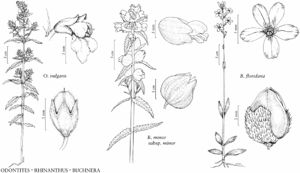Odontites vulgaris
Methodus, 439. 1794.
Stems 15–50 cm; unbranched or branched, branches 3–12 pairs, arising near base of stem, ascending. Leaves: blade lanceolate, 20–50 x 5–10 mm, marginal teeth 3–5, apex blunt, surfaces hispid. Racemes: 4–10 pairs of flowers; bracts foliaceous, 5–15 x 2–4 mm. Pedicels 2–3 mm. Flowers 8–10 mm; calyx often with purple markings, 4–6 mm, lobes less than 1/2 length of whole, puberulent; corolla-tube light purple, glabrescent, lobes pink, villous, abaxial lobes 3–4 x 2–3 mm, adaxial lip 4–5 mm; anthers slightly exserted, yellow, equal in size and length; style exserted, 8–10 mm. Capsules compressed-ellipsoid, 7–8 x 3–4 mm. Seeds 1–2 mm, reticulate. 2n = 18, 20.
Phenology: Flowering Jun–Aug.
Habitat: Roadsides, fields, disturbed areas.
Elevation: 0–700 m.
Distribution
Introduced; St. Pierre and Miquelon, Alta., Man., N.B., Nfld. and Labr. (Nfld.), N.S., Ont., P.E.I., Que., Sask., Maine, Mass., Mich., N.H., N.Y., Vt., W.Va., Wis., Eurasia
Discussion
Accurate identification of species of Odontites has been made difficult by a combination of complex taxonomic history, extreme variability in morphological characters across geographic ranges, and phenotypic plasticity (M. Bollinger 1996). The native range of O. vulgaris spans the Iberian Peninsula to Scandinavia and into Siberia. The expansion of its range in the New World is likely to continue into maritime grasslands (N. M. Hill and C. S. Blaney 2009) and elsewhere (Randolph County, West Virginia; Grafton s.n., WVA).
Largely due to taxonomic confusion among species that co-occur in its native range, specimens in the New World have been identified as either Odontites ruber Gilibert, O. serotinus Dumortier, or O. vernus Dumortier. The subspecific names of O. serotinus have been synonymized with names of other species, and O. serotinus, an illegitimate name, was treated as a synonym of O. vulgaris by M. Bollinger (1996). Odontites vulgaris differs from O. vernus in ploidy level, the latter being tetraploid (4n = 40), and by degree of branching (Bollinger), the latter with fewer branches occurring at acute angles. Branching characters are difficult to discern in preserved material; specimens from North America appear to be O. vulgaris. Reported chromosome counts indicate New World Odontites specimens are diploid (E. H. Moss and J. G. Packer 1983); undocumented tetraploids may also exist.
Red bartsia is classified as a prohibited noxious weed in the Canadian Seeds Act and Regulations.
Selected References
None.
Lower Taxa
"equal" is not a number.
